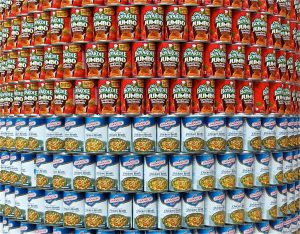Food Processing
University of Hawai‘i at Mānoa Food Science and Human Nutrition Program and Human Nutrition Program
Food processing includes the methods and techniques used to transform raw ingredients into packaged food. Workers in this industry use harvested crops or slaughtered and butchered livestock to create products that are marketed to the public. There are different ways in which food can be processed, from a one-off product, such as a wedding cake, to a mass-produced product, such as a line of cupcakes packaged and sold in stores.
The Pros and Cons of Food Processing

Food processing has a number of important benefits, such as creating products that have a much longer shelf life than raw foods. Also, food processing protects the health of the consumer and allows for easier shipment and the marketing of foods by corporations. However, there are certain drawbacks. Food processing can reduce the nutritional content of raw ingredients. For example, canning involves the use of heat, which destroys the vitamin C in canned fruit. Also, certain food additives that are included during processing, such as high corn syrup, can affect the health of a consumer. However, the level of added sugar can make a major difference. Small amounts of added sugar and other sweeteners, about 6 to 9 teaspoons a day or less, are not considered harmful.[1]
Food Additives
If you examine the label for a processed food product, it is not unusual to see a long list of added materials. These natural or synthetic substances are food additives and there are more than three hundred used during food processing today. The most popular additives are benzoates, nitrites, sulfites, and sorbates, which prevent molds and yeast from growing on food.[2] Food additives are introduced in the processing stage for a variety of reasons. Some control acidity and alkalinity, while others enhance the color or flavor of food. Some additives stabilize food and keep it from breaking down, while others add body or texture. Table 17.1 “Food Additives” lists some common food additives and their uses:
Table 17.1 Food Additives
| Additive | Reason for Adding |
| Beta-carotene | Adds artificial coloring to food |
| Caffeine | Acts as a stimulant |
| Citric acid | Increases tartness to prevent food from becoming rancid |
| Dextrin | Thickens gravies, sauces, and baking mixes |
| Gelatin | Stabilizes, thickens, or texturizes food |
| Modified food starch | Keeps ingredients from separating and prevents lumps |
| MSG | Enhances flavor in a variety of foods |
| Pectin | Gives candies and jams a gel-like texture |
| Polysorbates | Blends oil and water and keep them from separating |
| Soy lecithin | Emulsifies and stabilizes chocolate, margarine, and other items |
| Sulfites | Prevent discoloration in dried fruits |
| Xanthan gum | Thickens, emulsifies, and stabilizes dairy products and dressings |
Source: Chemical Cuisine: Learn about Food Additives. Center for Science in the Public Interest.http://www.cspinet.org/reports/chemcuisine.htm. Published 2012. Accessed January 20, 2018.
The Pros and Cons of Food Additives
The FDA works to protect the public from potentially dangerous additives. Passed in 1958, the Food Additives Amendment states that a manufacturer is responsible for demonstrating the safety of an additive before it can be approved. The Delaney Clause that was added to this legislation prohibits the approval of any additive found to cause cancer in animals or humans. However, most additives are considered to be “,” a status that is determined by the FDA and referred to as GRAS.
Food additives are typically included in the processing stage to improve the quality and consistency of a product. Many additives also make items more “shelf stable,” meaning they will last a lot longer on store shelves and can generate more profit for store owners. Additives can also help to prevent spoilage that results from changes in temperature, damage during distribution, and other adverse conditions. In addition, food additives can protect consumers from exposure to rancid products and foodborne illnesses.
Food additives aren’t always beneficial, however. Some substances have been associated with certain diseases if consumed in large amounts. For example, the FDA estimates that sulfites can cause allergic reactions in 1 percent of the general population and in 5 percent of asthmatics. Similarly, the additive monosodium glutamate, which is commonly known as MSG, may cause headaches, nausea, weakness, difficulty breathing, rapid heartbeat, and chest pain in some individuals.[3]
Learning Activities
Technology Note: The second edition of the Human Nutrition Open Educational Resource (OER) textbook features interactive learning activities. These activities are available in the web-based textbook and not available in the downloadable versions (EPUB, Digital PDF, Print_PDF, or Open Document).
Learning activities may be used across various mobile devices, however, for the best user experience it is strongly recommended that users complete these activities using a desktop or laptop computer and in Google Chrome.
- Sugar and Carbohydrates. American Heart Association. http://www.heart.org/HEARTORG/GettingHealthy/NutritionCenter/HealthyDietGoals/Sugars-and-Carbohydrates_UCM_303296_Article.jsp#. Updated April 20, 2017. Accessed January 4, 2018. ↵
- The Dangers of Food Additives. How Stuff Works. http://health.howstuffworks.com/wellness/food-nutrition/facts/dangers-of-food -additives.htm. Accessed October 5, 2011. ↵
- The Issues: Additives. Sustainable Table. http://www.sustainabletable.org/issues/additives/#fn14. Accessed October 10, 2011. ↵
A 6-carbon monosaccharide arranged in a ring structure that is found in fruits and honey.
A group of chemical additives that are considered safe in the food supply without harmful effects.
